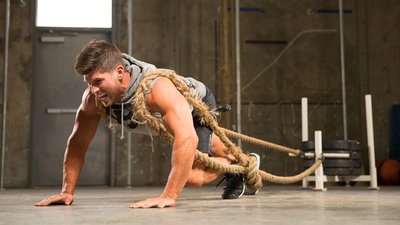You may have heard the stats, but even if you haven't you've probably heard enough stories that they won't surprise you. For starters, 80 percent of Americans will experience lower-back pain at some point in their lives, and at any given moment 31 million are actively in pain. As of 2010, lower-back pain was the leading cause of physical disability worldwide, and one of the most common reasons people missed work or visited the doctor's office. And the problem certainly hasn't gotten less common in the years since then.
The funny (not funny) thing is, both athletes and sedentary people seem equally prone to this type of pain. Many of us treat it as an inevitable byproduct of training hard…or of not training at all. It is just going to happen, and you are going to have to deal with it.
Lower-back pain hits very close to home for me, as well. At the young age of 14, I herniated several discs in my lower back. While I was able to overcome them in the short term, there was a constant back and forth with pain for years down the road. Eventually, 26 years later—and after many years of being a successful strength coach and personal trainer—those discs gave out, causing me to lose complete use of my right leg and requiring three lower back surgeries in a matter of two weeks. See, no one is immune.
All of a sudden, simply walking down the street was a challenge. However, I had a plan. Knowing I had to address core stability first, I sought out exercises that experts indicated could be most impactful in helping me regain my life.
These three moves did wonders for me, but also plenty of people with whom I've worked. While your situation is unique and a guaranteed prevention may not be possible, you have tools to reduce the likelihood of becoming another statistic. And if you're proactive in this area, you'll also get stronger and more resistant to injury.
Bird Dog with Sandbag Drag
In my quest for spinal resilience, I kept coming across the same name over and over: Dr. Stuart McGill, a world-renowned spine specialist who advocates what he calls the "Big 3" core-stability drills, one of which is the bird dog. If you've ever been in pain, you probably know that the bird dog is a classic component of rehabilitation. But that doesn't mean you need to wait until you're in rehab to benefit from it.
This movement is great because it teaches the body how to stabilize while the extremities are moving. Most people don't realize that the major function of the core isn't to create movement but to resist movement. Or as the distinguished physical therapist Shirley Sahrmann says, "to provide isometric support and limit the degree of rotation of the trunk."
But like anything else, the bird dog can be done incorrectly. Most people can't resist movement and have excessive extension in their lower back or rotate their hips excessively while they perform the movement, which is the exact opposite of what it should look like. Here's how to dial in your basic bird dog:
- Grip the ground with both your hands and feet. This turns on the lat muscles, but also the hamstrings and glutes. These are all crucial protectors of your lower back.
- Create ab tension. As powerlifting legend Andy Bolton said, "The strong guys all have one thing in common: they know how to get tight. Without tightness, you cannot have strength. All the best lifters get tighter than the average lifters. Simple as that."
Of course, not everything that applies to a man who can deadlift 1,000 pounds applies to someone struggling to get out of bed, but in this case, we should all listen.
Once you've got the basics of the bird dog mastered it can be tempting to abandon it, but I'd say you should progress it. Adding a lateral sandbag drag allows you to maintain and further develop the connection of the lats, core, and glutes, which is the real goal of the exercise.
The difference between the progression and the basic version may seem obvious visually, but I find it benefits from a bit of unpacking. Rather than simply hammering out reps, as people sometimes do with basic bird dogs once they're accustomed to them, move slowly and deliberately, matching the dragging to the hip extension. As you extend your rear leg, really attempt to feel your butt and back muscles working. As you can see in the video, either adding a light mini-band to the rear leg or placing it in the stirrup of a suspension system can hammer this sensation home.
When people perform this drill, they inevitably feel their core light up, but that's only the most obvious thing going on. With practice, they also better understand how to keep their pelvis "still" while their legs and arms move. You will be shocked at how this simple exercise not only makes you more resilient, but helps your squats, presses, and many other exercises get stronger!
Weighted Sled Drags
Weighted sleds were one of the first "alternative" strength-building tools I started using in the early 2000s, and I was instantly a fan. Their versatility and lack of an eccentric (muscle-lengthening) component made it a great way to train the core and hips in a wide range of angles that are hard to replicate on other equipment. Your legs, lungs, and plenty more get worked, but with minimal risk to the lower back.
Dr. McGill is also a fan, as he stated in an interview with T Nation.
"Usually the best exercise is the one that creates the largest effect with the minimal risk to the joints," he explains. "If the purpose is to create hip extension power, then exercises such as weighted carries and sled drags have to be considered."
Loaded carries are great, but given how hard it can be for some people simply to get the weight safely into position, they can still be risky. In that case, the sled can provide some of the same benefits without the potential negatives.
Different patterns of sled pulling or dragging, as well as loaded sled crawls, hit the smaller stabilizers of the body that many popular exercises don't train, but which develop just the kind of muscular integration that can help protect against lower-back injury. Best of all, these exercises are generally easy to learn, so you can spend more time training than trying to learn and relearn overly complex exercises.
Once you're ready, you can progress sled work in plenty of interesting directions. Here are a few of my favorites:
- Overhead lunges pulling a sled with one arm
- Lateral crab walking pulling a sled
- Crawling pulling a sled
- Lateral steps with handle in front (Pallof press-style)
- Carioca steps with handle in rear hand
- High steps
- Alternating between backward and forward walking
Lunges
Lunges still get a bad rap for being a "firming and toning" exercise, when in reality, they are a very powerful corrective and functional strength exercise. As you move between the highly stable standing position and the more precarious split stance, the change in stability demands you simultaneously resist and produce force, something it shares with both bird dogs and sled work.
The up-and-down motion of the lunge isn't what catches most lifters, though. It's the side-to-side instability. Lateral stability, I've found, is a serious missing link in many people's training, and I actually prefer to train it with the lunge before moving to exercises like loaded carries.
Why lunge first? While we often think of walking as a simple movement pattern, it is actually one of great complexity that requires stability, strength, and control—especially when weight is added. Using these lunge progressions can help you build stability and coordination you'll need when you start incorporating, say, loaded carries.
These are a few of my favorite variations to keep in the mix:
- Dumbbell reverse lunges from knees
- X-pattern kettlebell lunge to balance step (one KB in the rack, the other at your side)
- Rotational or "max" lunge using an Ultimate Sandbag
When and How?
The bird dog series can be used as part of a warm-up, or it could function as a "push" exercise in a program. In my experience, the attributes trained by the bird dog have fantastic carry-over to push-ups and other pushing exercises that not only train the upper body, but the body as a single unit.
Sled work can be used as an entire training session in and of itself, or substituted as a more dynamic version of other movement patterns. For example, sled presses or pulls can be used as one of the dominant upper-body exercises. Lateral, forward-facing, or rear-facing drags in different directions can serve as a hip-dominant drill to emphasizes the hamstrings and glutes.
Lunges are easier to see in training as they exist in a lot of fitness programs already. However, I'm of the opinion that their priority should increase in training. In practical terms, we often put lunges after exercises like squats and deadlifts, when they should really come before. It's a well-established training principle that exercises that require more complexity are best done earlier in the workout, and lunges definitely fit the bill. In my experience, they'll actually make you better at exercises like squats and deadlifts.
To be clear, lower-back pain isn't a certainty for anyone. But more importantly, if you already have it, you aren't condemned to a life of pain and discomfort. There is a lot you can do to improve your strength, health, performance, and how you function every day. Try integrating some of these exercises into your workouts and feel the difference!

